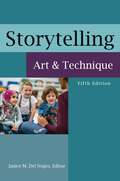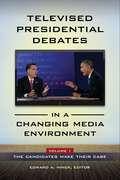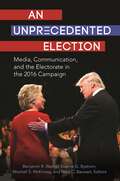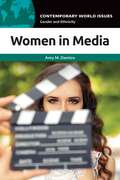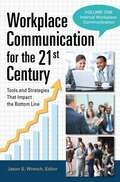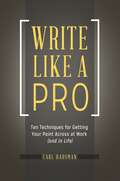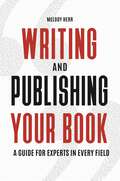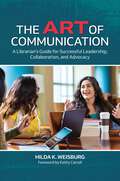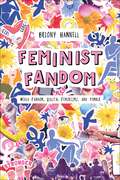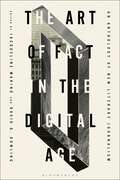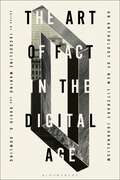- Table View
- List View
Storytelling: Art and Technique
by Janice M. Del NegroThis book serves as both a textbook and reference for faculty and students in LIS courses on storytelling and a professional guide for practicing librarians, particularly youth services librarians in public and school libraries.Storytelling: Art and Technique serves professors, students, and practitioners alike as a textbook, reference, and professional guide. It provides practical instruction and concrete examples of how to use the power of story to build literacy and presentation skills, as well as to create community in those same educational spaces.This text illustrates the value of storytelling, covers the history of storytelling in libraries, and offers valuable guidance for bringing stories to contemporary listeners, with detailed instructions on the selection, preparation, and presentation of stories. It also provides guidance around the planning and administration of a storytelling program. Topics include digital storytelling, open mics and slams, and the neuroscience of storytelling. An extensive and helpful section of resources for the storyteller is included in an expanded Part V of this edition.
Televised Presidential Debates in a Changing Media Environment [2 volumes]: [2 volumes]
by Edward A. HinckThis two-volume set examines recent presidential and vice presidential debates, addresses how citizens make sense of these events in new media, and considers whether the evolution of these forms of consumption is healthy for future presidential campaigns—and for democracy.The presidential debates of 2016 underscored how television highlights candidates' and campaigns' messages, which provide fodder for citizens' widespread use of new media to "talk back" to campaigns and other citizens. Social media will continue to affect the way that campaign events like presidential debates are consumed by audiences and how they shape campaign outcomes. This two-volume study is one of the first to examine the relationship between debates as televised events and events consumed by citizens through social media. It also assesses the town hall debate format from 1992 to 2016, uses the lens of civil dialogue to consider how citizens watch the debates, and considers the growing impact of new media commentary on candidate images that emerge in presidential and vice presidential debates.Televised Presidential Debates in a Changing Media Environment features contributions from leading political communication scholars that illuminate how presidential debates are transforming from events that are privately contemplated by citizens, to events that are increasingly viewed and discussed by citizens through social media. The first volume focuses on traditional studies of debates as televised campaign events, and the second volume examines the changing audiences for debates as they become consumed and discussed by viewers outside the traditional channels of newspapers, cable news channels, and campaign messaging. Readers will contemplate questions of new forms, problems, and possibilities of political engagement that are resulting from citizens producing and consuming political messages in new media.
An Unprecedented Election: Media, Communication, and the Electorate in the 2016 Campaign
by Benjamin R. Warner, Dianne G. Bystrom, Mitchell S. McKinney, and Mary C. Banwart, EditorsWritten by leading scholars in the field of political communication, this book provides a comprehensive accounting of the campaign communication that characterized the unprecedented 2016 presidential campaign.The political events leading up to election day on November 8, 2016, involved unprecedented events in U.S. history: Hillary Clinton was the first female to be nominated by a major party, and she was favored to win the highest seat in the nation. Donald Trump, arguably one of the most unconventional and most-unlikely-to-succeed candidates in U.S. history, became the leading candidate against Clinton. Then, an even more surprising thing happened: Trump won, an outcome unexpected by all experts and statistical models.An Unprecedented Election: Media, Communication, and the Electorate in the 2016 Campaign presents proprietary research conducted by a national election team and leading scholars in political communication and documents the most significant—and in some cases, the most shocking—features of the 2016 U.S. presidential election. The information presented in this book is derived from national surveys, experiments, and textual analysis, and it will help readers to grasp the truly unique characteristics of this campaign that make it unlike any other in U.S. history. The chapters explain the underlying dynamics of this astonishing election by assessing the important role of both traditional and social media, the evolving (and potentially diminishing) influence of televised campaign advertisements, the various implications of three historic presidential debates, and the contextual significance of convention addresses. Readers will come away with an appreciation of the content and effects of the campaign communication and media coverage as well as the unique attributes of the electorate that ultimately selected Donald Trump as the 45th president of the United States.
Women in Media: A Reference Handbook (Contemporary World Issues)
by Amy M. DamicoThis title provides a broad overview of how women are portrayed and treated in America's news and entertainment industries, including film, television, radio, the internet, and social media.This book provides a one-stop resource for understanding the participation and representation of women in the U.S. media in such areas as narrative film, scripted television programming, advertising, video games, news, and sports. Coverage is wide-ranging and comprehensive, covering historical developments and trends as well as such relevant issues as gender disparities in pay and advancement opportunities, stereotypical gender portrayals in popular entertainment, sexual harassment in America's media and entertainment industries, and the dearth of positive media representations of women of color.Engaging with this history and reading about current issues related to this topic will be useful to those interested in understanding more about why women's engagement in media—in such roles as performer, journalist, producer, and writer—is important. It will also help readers better understand how and why problematic media representations of women hinder efforts to achieve full gender equality in American society.
Workplace Communication for the 21st Century [2 volumes]: Tools and Strategies That Impact the Bottom Line [2 volumes]
by Jason S. WrenchWritten in clear, non-technical language, this book explains how employees and employers can maximize internal and external organizational communication—for both personal benefit and to the entity as a whole.Workplace Communication for the 21st Century: Tools and Strategies That Impact the Bottom Line explains and simplifies what organizational communication scholars have learned, presenting this knowledge so that it can be easily applied to generate tangible benefits to employees and employers as they face everyday challenges in the real world.This two-volume work discusses internal organizational and external organizational communication separately, first explaining how communication functions within the confines of a modern organization, then addressing how organizations interact with various stakeholders, such as customers, clients, and regulatory agencies. The expert contributors provide a thorough and insightful view on organizational communication and supply a range of strategies that will be useful to practitioners and academics alike.
Write Like a Pro: Ten Techniques for Getting Your Point Across at Work (and in Life)
by Carl HausmanFor those looking to become great business writers, this practical guide supplies clear instruction and examples of how to organize thoughts into written form, impart information with pinpoint accuracy, persuade, and hold the reader's interest: in short, to use language to get what you want.In today's business world, writers need to be prepared and comfortable with various forms of writing: reports, blogs, social media, white papers. Written by an established expert on writing and communication, journalism professor Carl D. Hausman, Write Like a Pro: Ten Techniques for Getting Your Point Across at Work (and in Life) can make you a better writer, regardless of your experience and current skill level; and will teach you how to vastly improve your written communication through a straightforward, easy-to-follow method.This book doesn't just cover the essential "mechanics" of good writing; it focuses on developing the more subtle skills of infusing your writing with eloquence, power, accuracy, and persuasiveness—and it shows readers how to achieve those qualities with no-nonsense advice. The information is highly accessible, sometimes amusing, and replete with memorable examples that demonstrate what works and teaches a strategy for solving any writing problem. It is essential reading for anyone who wants to write effectively, in any form, from emails to complaint letters to social media.
Writing and Publishing Your Book: A Guide for Experts in Every Field
by Melody Herr Ph.D.Are you ready to write your book? Partner with an experienced publisher, writing coach, and author and find out how to turn your research and scholarship into a book.This book is the next-best-thing to a personal writing coach. Drawing upon her own extensive experience as an author and publisher, Melody Herr guides the reader through every step of the writing and publishing process: constructing a table of contents, preparing a proposal, finding a publisher, negotiating a contract, drafting the manuscript, and marketing the finished product. Throughout, she offers proven strategies for producing a book that highlights its author's authoritative knowledge and writing skills. Unique among writing guides, Writing and Publishing Your Book: A Guide for Experts in Every Field acknowledges the reader's own expertise; speaks to researchers and scholars across the sciences, social sciences, and humanities; and provides information and guidance that will benefit junior authors as well as their more senior colleagues. By following these practical, step-by-step instructions, new authors will more easily liberate their own creativity while avoiding the many pitfalls that mire new writers, thereby maintaining momentum for a successful publication.
The Art of Communication: A Librarian's Guide for Successful Leadership, Collaboration, and Advocacy
by Hilda K. WeisburgLibrarians will learn communication skills that help them develop as leaders, build community, and advocate for their libraries.Librarians understand the importance of making the value of the library known to stakeholders. In this informative and conversational book, Hilda K. Weisburg gradually builds librarians' communication skills, which are intrinsic to the success of library programs and services. Being able to effectively communicate as a sender and receiver of messages is a vital leadership skill, and librarians must master all the multi-faceted ways people exchange information in order to grow as leaders.Throughout the book, librarians will learn communication basics and the obstacles that interfere with successful communication. The chapters in part one detail the three components of communication; part two prepares librarians to cope with difficult communications; and part three gives librarians further techniques to ensure their messages are cohesive and strategic as they reach out to stakeholders.The book's goal is for librarians to feel confident about using their newly learned communication skills for advocacy. As their value to the library community grows, they will be able to strategically use the relationships their communications have built to create positive change.
Feminist Fandom: Media Fandom, Digital Feminisms, and Tumblr
by Briony HannellExamines how fannish and feminist modes of cultural consumption, production, and critique are converging and opening up informal spaces for young people to engage with feminism. Adopting an interdisciplinary theoretical framework and bringing together media and communications, feminist cultural studies, sociology, internet studies and fan studies, Hannell locates media fandom at the intersection of the multi-directional and co-constitutive relationship between popular feminisms, popular culture and participatory networked digital cultures. Feminist Fandom functions as an ethnographic account of how feminist identities are constructed, lived and felt through digital fannish spaces on the micro-blogging and social networking platform, Tumblr.
Feminist Fandom: Media Fandom, Digital Feminisms, and Tumblr
by Briony HannellExamines how fannish and feminist modes of cultural consumption, production, and critique are converging and opening up informal spaces for young people to engage with feminism. Adopting an interdisciplinary theoretical framework and bringing together media and communications, feminist cultural studies, sociology, internet studies and fan studies, Hannell locates media fandom at the intersection of the multi-directional and co-constitutive relationship between popular feminisms, popular culture and participatory networked digital cultures. Feminist Fandom functions as an ethnographic account of how feminist identities are constructed, lived and felt through digital fannish spaces on the micro-blogging and social networking platform, Tumblr.
The Art of Fact in the Digital Age: An Anthology of New Literary Journalism
The Art of Fact in the Digital Age is a showcase of the most powerful and moving journalism of the past 25 years. Selections include stories originally published in established bastions of literary journalism (The New York Times, The Atlantic and The New Yorker), as well as those from specialized and online publications (Runner's World, The Atavist). It features writers of extraordinary style (including Carina del Valle Schorske, Brian Phillips, and Jia Tolentino), as well as those who have profoundly influenced public discourse on the 21st century's most urgent issues: Mitchell S. Jackson, Clint Smith, and Ta-Nehisi Coates on race; Susan Dominus and Luke Mogelson on migration; and Kathryn Schulz and David Wallace-Wells on environmental threats. It even includes one story that expanded literary journalism's repertoire into audio (This American Life). This collection, assembled for students, scholars, and practitioners alike, also charts the evolution of digital longform journalism through its greatest achievements, from transitioning readers to screens to the integration of multimedia with words in service of meaning. The art of fact in the 21st century opened new ranges of expression to address such issues, while uniquely bearing the imprint of their generation's digital cultures and technologies. Although many forces compete for attention in the digital age, story triumphs. The works in this anthology show us why.
The Art of Fact in the Digital Age: An Anthology of New Literary Journalism
by Jacqueline Marino and David O. DowlingThe Art of Fact in the Digital Age is a showcase of the most powerful and moving journalism of the past 25 years. Selections include stories originally published in established bastions of literary journalism (The New York Times, The Atlantic and The New Yorker), as well as those from specialized and online publications (Runner's World, The Atavist). It features writers of extraordinary style (including Carina del Valle Schorske, Brian Phillips, and Jia Tolentino), as well as those who have profoundly influenced public discourse on the 21st century's most urgent issues: Mitchell S. Jackson, Clint Smith, and Ta-Nehisi Coates on race; Susan Dominus and Luke Mogelson on migration; and Kathryn Schulz and David Wallace-Wells on environmental threats. It even includes one story that expanded literary journalism's repertoire into audio (This American Life). This collection, assembled for students, scholars, and practitioners alike, also charts the evolution of digital longform journalism through its greatest achievements, from transitioning readers to screens to the integration of multimedia with words in service of meaning. The art of fact in the 21st century opened new ranges of expression to address such issues, while uniquely bearing the imprint of their generation's digital cultures and technologies. Although many forces compete for attention in the digital age, story triumphs. The works in this anthology show us why.
Rediscovering Rubén Darío through Translation
by Dr. Carlos F. GrigsbyA long overdue examination of Rubén Darío's multilingual work and influences alongside the contexts and politics of canonization in world literature. Rediscovering Rubén Darío through Translation addresses the peculiar obscurity of Darío by asking these questions: How can one of the most important writers of a major world language be almost entirely unknown in the English-speaking world? How is it that other writers of the same language (e.g., Lorca or García Márquez) achieve widespread recognition in the anglophone world, while he remains unnoticed? What role does translation play in this? What can it tell us about the way in which world literature is articulated? Carlos F. Grigsby approaches Darío's oeuvre through translation. In doing so, he explores not only the place of Darío in the translation of Spanish American literature into English, but also the place of translation in Darío's own writing. The result is a double-sided painting, as it were: the recto is titled “Translation in Darío” and the verso “Darío in Translation.” This book challenges the field of world literature by revealing some of the biases present in its representation of Spanish American literature. It adopts a multilingual framework – chiefly using English, Spanish, French, and to a lesser degree Latin and Catalan – in analyzing Darío's writing alongside that of his contemporaries. As a result, it reveals the multilingualism of Darío's own writing, opening new avenues for the study of his work and of Spanish American modernismo more generally.
Rediscovering Rubén Darío through Translation
by Dr. Carlos F. GrigsbyA long overdue examination of Rubén Darío's multilingual work and influences alongside the contexts and politics of canonization in world literature. Rediscovering Rubén Darío through Translation addresses the peculiar obscurity of Darío by asking these questions: How can one of the most important writers of a major world language be almost entirely unknown in the English-speaking world? How is it that other writers of the same language (e.g., Lorca or García Márquez) achieve widespread recognition in the anglophone world, while he remains unnoticed? What role does translation play in this? What can it tell us about the way in which world literature is articulated? Carlos F. Grigsby approaches Darío's oeuvre through translation. In doing so, he explores not only the place of Darío in the translation of Spanish American literature into English, but also the place of translation in Darío's own writing. The result is a double-sided painting, as it were: the recto is titled “Translation in Darío” and the verso “Darío in Translation.” This book challenges the field of world literature by revealing some of the biases present in its representation of Spanish American literature. It adopts a multilingual framework – chiefly using English, Spanish, French, and to a lesser degree Latin and Catalan – in analyzing Darío's writing alongside that of his contemporaries. As a result, it reveals the multilingualism of Darío's own writing, opening new avenues for the study of his work and of Spanish American modernismo more generally.
